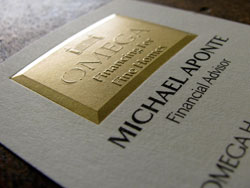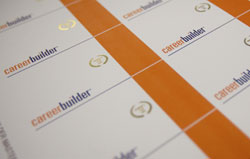> Printing capabilities
Offset
Thermography
Engraving
Embossing
Foil Stamping>
Letterpress
Digital
FOIL STAMPING
a.k.a. hot stamping, flat stamping, gold stamping

Nothing says "fancy" like foil stamping. Using foil in the design of your stationery, invitations, greeting cards or packaging will add a bit of gleam that will catch anyone's eye. Foil stamping creates a smooth opaque image for fine lines or large solids, and is a great way to create metallic effects.
Offering a wide variety of colors and patterns, foil stamping can add richness to images and type. Often seen as metallics, (gold, silver, etc.) foils are also available in hundreds of colors, clear, tints or holographic patterns.
Foil stamping is elegant on its own but when combined with blind or foil embossing, and any other print processes such as engraving, thermography, die cutting, or offset printing, you can create a dazzling array of effects.
Foils are opaque, except, of course, for clears or tints, so you can use a light colored foil on a dark paper and expect excellent coverage. Foil stamping on smooth paper stocks produces the best results. If you desire to stamp on a textured stock it may require extra pressure to flatten the texture of the paper to insure proper foil adhesion.
Foil Stamping process
1. The image to be stamped is made into a stamping die, typically made of magnesium or copper for flat stamping, brass for multi-level, sculptured or combination dies.
2. The die is mounted in a press and heated to 170 to 240 degrees F.
3. Foil is pulled across the heated surface of the die.
4. The paper is pressed to the foil, transferring the pigment from the carrier sheet to the printed piece.
